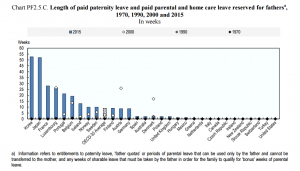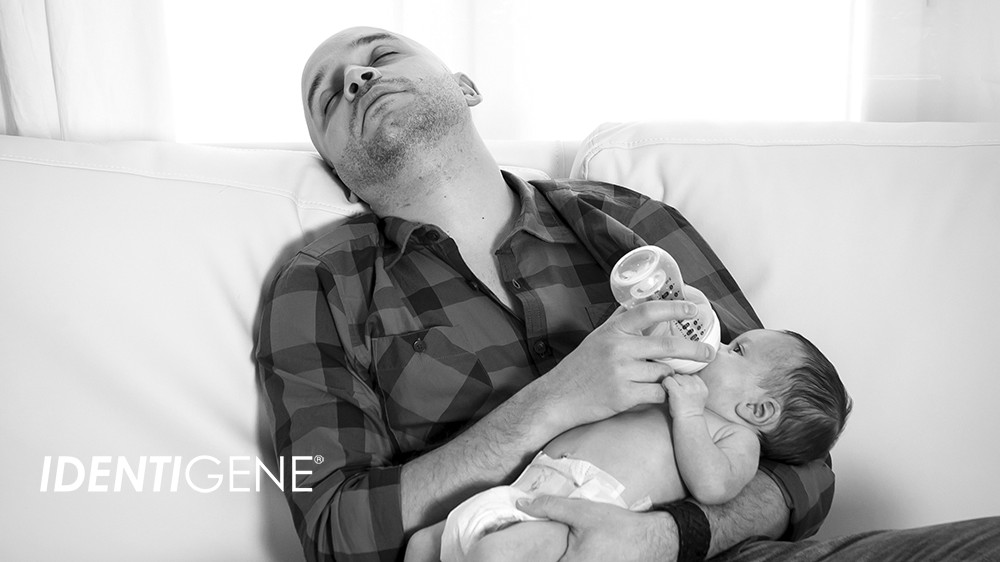So How Long is Your Paternity Leave?
If you were to overhear the conversations happening in a big group of new moms and dads, there would no doubt be talk about sleepless nights, which diaper brand is best, and how long everyone’s labor was. But listen longer and a different topic might bubble to the surface: ‘How much time off work do you get?’ And it’s not just the moms talking. Taking paternity leave is a hot trend for today’s dads. They want to take a more active part in their child’s upbringing and have time for bonding with their infant. As family roles continue to evolve, so have attitudes toward men taking paternity leave after the birth of a child.
We’ve Come a Long Way, Baby
The concept of paternity leave is almost brand-spanking new. In fact, paid maternity leave isn’t that old either, really. As late as 1965, only 14% of mothers participated in the workforce within six months of their child’s birth (O’Connell). By 2014, that number had risen to 57.1%, and the number of employed dads with children under age 18 was 92.8% (Bureau of Labor Statistics). So the need for maternity (and paternity!) leave has skyrocketed, to say the least.
What’s Happening Right Now
In Europe
One of the biggest trends across the western world is unpaid shared parental leave. In Great Britain, for example, only women still have the right to six weeks’ leave at 90% of full earnings. But in 2015, the UK implemented shared parental leave, wherein working couples can share up to 50 weeks off (Campbell-Barr). It can be a straight paternity leave, if a couple chooses-a feature that is especially useful if the mother makes a higher income.
Two European countries have been on the forefront of paid paternity leave. In 2009, Portugal reserved 20 weeks of paid leave for dads, and in 2014 France introduced up to six months of paid paternity leave. However, Austria and Denmark have reduced dads’ benefits since 2000, due to a variety of reasons (OECD).
And then there’s Sweden. Swedish parents are entitled to 480 days of paid parental leave. 90 of those days are allotted to paternity leave for dads. However, it’s important to keep in mind that Sweden has one of the highest rates of taxation in the world and relatively few children, which help make this dream scenario possible.
In Asia
Incredible reforms have happened in two Asian companies, and they happened years ago! Since 2008 and 2010 respectively, fathers in Korea and Japan are entitled to a full year of paid paternity leave!
In the United States
As a country, the United States is one of only a handful of advanced economies that do not offered paid paternity leave. As indicated by the chart below, The U.S. lags way behind and is still living in 1970 when it comes to these benefits-both paid and unpaid.
In America it is up to employers to provide paternity leave benefits, even paid time off, and many do so as a carrot to prospective employees. But providing parental leave is expensive, and so only 4% of the bottom wage earners get any kind of leave at all (Reed/Borison). Even if unpaid paternity leave is offered, many men don’t take it because their families can’t afford to do without their income.
Nevertheless, according to a 2017 Pew Research Study, 69% of respondents say fathers should receive paid leave following the birth or adoption of their child.

(CHART COURTESY OF OECD.ORG)
The Bottom Line
Although improvements in public attitudes have been getting better, there’s still a long way to go when it comes to employers’ attitudes. Like any other benefit, this is one that would need to be paid for, and in a still-shaky economy, many companies are willing to take such a financial hit. As a top paternity test company, we understand the value of children knowing their dads and forming positive relationships and bonds with them whenever possible. There are many companies in the United States that are leading out with providing paid and unpaid paternity leave, but we think there are still too few. Dads matter!
What do you think? Tell us in the comments.
Follow us on Facebook and Twitter! If you have questions about paternity tests or other DNA testing services, please contact our Client Support Center at 888-404-4363, Mon-Fri from 9 AM to 6 PM Eastern Time. Our friendly, expert representatives are ready and happy to help. Get answers anytime by visiting our Help Center.
Sources
“10 Things That Make Sweden Family-friendly.” Sweden.se. Swedish Institute, 24 Oct. 2013. Web. 29 Mar. 2016. <http://sweden.se/society/10-things-that-make-sweden-family-friendly/>.
“3.6. Trends in Wage Dispersion Since 1970.” (n.d.): n. pag. OECD Family Database. OECD, 4 Mar. 2016. Web. 29 Mar. 2016. <http://www.oecd.org/els/family/PF2_5_Trends_in_leave_entitlements_around_childbirth.pdf>.
Campbell-Barr, Elyssa. “Shared Parental Leave: ‘nightmare’ New Rules, or the First Baby Steps to Equality?” The Guardian. Guardian News and Media, 11 Apr. 2015. Web. 29 Mar. 2016. <http://www.theguardian.com/money/2015/apr/11/shared-parental-leave-rules-equality>.
“Employment Characteristics of Families Summary.” U.S. Bureau of Labor Statistics. U.S. Bureau of Labor Statistics, 23 Apr. 2015. Web. 29 Mar. 2016. <http://www.bls.gov/news.release/famee.nr0.htm>.
O’Connell, M.; B. Downs; K. Smith (2001). “Maternity Leave and Employment Patterns: 1961-1995”. Current Population Reports 70 (79): 1-21.
Reed, Eric, and Rebecca Borison. “8 Best Companies for Paid Parental Leave.” TheStreet. The Street, Inc., 16 Mar. 2016. Web. 29 Mar. 2016. <http://www.thestreet.com/story/13249442/1/7-best-companies-for-paid-parental-leave.html>.









